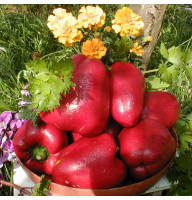Pepper can begin to get rid of future fruits at any stage of their development - the appearance of buds, flowering and the formation of ovaries. Sometimes this problem becomes widespread. What should you pay attention to in such a situation and how to correct it?
First, take a good look at the plants. If they have only dropped a couple of flowers or ovaries, then there is nothing much to worry about. But if the buds on a bush are dropped en masse or even dry out, you should be wary. This means that some of the conditions are categorically not suitable for the nightshade culture, and it uses this simple way to inform you about it. Let's consider all the reasons for what is happening - harmless and not so.
«Extra» buds of pepper

Any cultivated plant leaves itself such a number of ovaries that its root system is able to feed it. Therefore, the fall of a small amount is quite acceptable and there is no need to panic. Some gardeners even recommend picking off the first buds of the pepper themselves, so that the root system of the bush is strengthened and subsequently it grows new healthy ovaries. However, if you are not a supporter of such methods, trust the plants themselves. Believe me, they will throw off everything that bothers them.
The situation takes a different turn when the fall of buds becomes global.
Pepper has a large number of stepsons

Like another nightshade crop - tomatoes - the shoots of peppers must be removed. Only bushes of determinate varieties can avoid this fate, which inactively form stepchildren, and no more than 10 ovaries are «thrown away» on the main branches. In other cases, pinching pepper is considered one of the mandatory procedures. In addition to the stepsons, you also need to remove the «crown» flowers remaining on the plant - those that form on the fork of the main shoot.
Temperature changes when growing peppers

In the second half of summer, the daytime temperature still holds its own, but at night your bushes may be cool. This applies to both air and ground temperatures. As a result, you may observe curling of pepper leaves, as well as loss of ovaries by the plant. To correct the situation, reduce the difference between day and night temperatures: ventilate the plantings during the day and place containers of water near them, and on cool nights, completely close the greenhouse or install an automatic ventilation system there. In open ground, cover plants at night. Mulch the soil under the plants, but renew the layer of mulch every 3-4 weeks.
Irregular watering of peppers

Peppers can drop buds both from underwatering and from overwatering. At the root of the plant, water 1-2 times a week with warm water at the rate of 15-20 liters per 1 sq.m. In this case, the soil under the bushes should be moistened to a depth of at least 25-30 cm. However, if the temperature outside the window does not reach 15°C, watering should be suspended to avoid some crop diseases.
It is also important to follow the general rules for watering plants: water the plants in the morning (before the sun) or in the evening (after it). The ideal solution to the problem is drip irrigation.
Lack of lighting when growing peppers

Experts say that pepper lighting is closely related to the air temperature outside the window. So, in hot weather (about 30°C) the luminous flux should be bright. But in cloudy weather in summer, the temperature should be kept within 20-22°C. However, during hot weather in bright light, another problem may arise: the plants may wilt slightly. This can be solved by providing the bushes with shelter in the form of a light, breathable material.
Unbalanced nutrition of pepper

Not least important is how and what you feed your nightshade crops with. Experienced gardeners claim that peppers can shed flowers and ovaries both from a lack of nutrition and from an excess of fertilizers.
Even before fruiting begins (at the very end of flowering or at the stage of the appearance of ovaries), peppers are fed with a composition of 10 g of ammonium nitrate, 25 g of superphosphate and 25 g of potassium sulfate, dissolved in 10 liters of water. Instead, you can use complex fertilizers for tomatoes and peppers according to the instructions.
3-4 weeks after this, fertilizing is repeated, removing saltpeter from the composition. In the first half of summer, you can replace mineral fertilizers with a solution of bird droppings (1:20), manure (1:10) or herbal infusion (1:5), and in the second half, use ash infusion (2 cups of ash per 10 liters of water). To avoid causing burns on the roots of the pepper, the bushes are watered beforehand.
Active shedding of buds by a plant can also cause an excess of nitrogen in the soil. In this case, the bush “fattens” - the stem thickens and a thick green mass grows. If this is your case, remove nitrogen from the fertilizing and replace «prefabricated» fertilizers with a humic complex or ash.
Pepper diseases and pests

Any infection that may have infected your pepper can have an indirect effect on fruiting. And since there are many of them, we recommend that you carefully examine the plants, check the signs, and only then begin treating the crop.
Don’t be lazy to carry out preventive treatments of pepper against diseases and pests in a timely manner - this will automatically reduce the number of reasons why buds and ovaries fall off, as well as the time spent on eliminating the problem.
Unfortunately, potential problems with pepper fruiting are not limited to the loss of buds, flowers and ovaries. Sometimes the plant may lose already ripening fruits.









